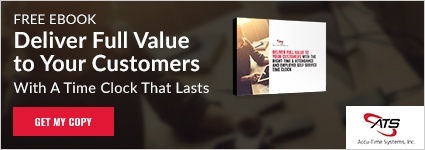The first big win customers experience when moving to electronic employee time clocks to collect the data flowing into your time and attendance system is more accurate payroll. With the American Payroll Association estimating that manual time collection translates into a 1-8% error rate in payroll, a key selling point for any time & attendance solution is realizing the direct and indirect savings of a more accurate payroll – to mention nothing of better relations between employees and the company.
Yet for customers to benefit from the full potential of your solution, they need a lot more than simply getting time card reports. Your software package comes with a variety of pre-built time and attendance reports and probably the capability for companies to build custom reports. However, they can’t use your reports or build their own if they aren’t collecting the right data.
Good data starts with the time clock
For some companies, a simple punch clock (punch-in/punch-out) will be sufficient. Each employee has a fixed pay rate that doesn’t vary by role. They don’t need to collect attestations from employees that they’ve completed certain trainings or that they haven’t witnessed a workplace accident when they punch out for the day. For companies with more complicated workforce management requirements, having a time clock with the interface and processing power that can accommodate collecting a wider variety of data improves the power of your time and attendance reporting functionality.
With a more sophisticated time clock, every employee that works for multiple departments or in roles at different pay rates can enter their role and department shifts in real time. This not only improves payroll accuracy, but provides the data foundation for management to look into actual department charge-back costs and labor costs for different roles. Collecting attestations through an employee time clock that also captures the date and time, along with the photo of the person making the attestation, improves compliance reporting.
More accurate reporting – more quickly
Large workforces with complicated scheduling need information as quickly as possible to ensure shifts are properly staffed, that the company isn’t allowing unnecessary overtime, and individual employees aren’t working more hours at a time than the law allows. Managers making decisions need the accurate information. Companies that continue to use manual shift or vacation request processes don’t have current information when they’re making decisions about who can take time off or who can take an extra shift this week without breaking labor laws.
When your customers use an employee time clock with the capacity to function as an employee self-service kiosk, updated data about schedules flows regularly into the back-end systems multiple times a day. Instead of waiting for a manager or someone in HR to approve a change and enter it into the system, the entire shift management process is handled electronically – starting with the employee checking the schedule and submitting a request through the time clock.
Help your customers maximize the value of your time and attendance system
The more relevant data you can help your customers get into their system, the more valuable time and attendance reporting and analysis opportunities they have. While backend integrations with payroll systems and workforce management systems are important, the frontline data comes from the employees. Present them with the right time clock that can collect the data your customer needs. Then you’ve simplified their data collection and amplified your system’s value to them.




